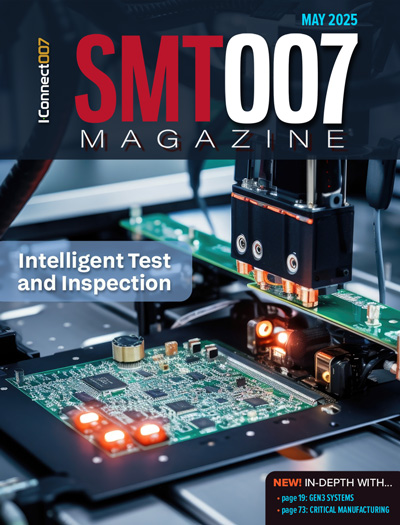-

- News
- Books
Featured Books
- smt007 Magazine
Latest Issues
Current Issue
What's Your Sweet Spot?
Are you in a niche that’s growing or shrinking? Is it time to reassess and refocus? We spotlight companies thriving by redefining or reinforcing their niche. What are their insights?

Moving Forward With Confidence
In this issue, we focus on sales and quoting, workforce training, new IPC leadership in the U.S. and Canada, the effects of tariffs, CFX standards, and much more—all designed to provide perspective as you move through the cloud bank of today's shifting economic market.

Intelligent Test and Inspection
Are you ready to explore the cutting-edge advancements shaping the electronics manufacturing industry? The May 2025 issue of SMT007 Magazine is packed with insights, innovations, and expert perspectives that you won’t want to miss.
- Articles
- Columns
- Links
- Media kit
||| MENU - smt007 Magazine
The Authors of the Printed Circuits Handbook 'Speak'
August 30, 2016 | I-Connect007Estimated reading time: 2 minutes
Editor’s Note: The seventh edition of the Printed Circuits Handbook was published this spring, which was also the 50th anniversary of the first edition. For this issue—“Voices”—we asked the many authors of the handbook for their thoughts—their voices. We asked a few questions to get them started; though not everyone spoke strictly about the handbook, we found their comments interesting and thought-provoking, and we hope you do as well. We begin with a wonderful history of the Handbook by the main man himself, Clyde Coombs.
Clyde Coombs Editor-in-Chief (Chapter 1)
The Printed Circuits Handbook is now in its seventh edition, and we are observing the 50th anniversary of the publication of the first edition. This long-term level of importance in an industry is remarkable, but the need for this book seems obvious today. This is to put the concept of the book into the context of the industry when the first edition was published, and try to explain why there was a book in the first place, and what led to this long string of successful subsequent editions.
Touring a modern, technology- and capital-intensive, highly-automated printed circuit factory of today, supported by a staff of trained specialists, many with advanced degrees in science, engineering and systems, would be a totally different experience than touring a printed circuit shop of 1959. For the most part, those shops were the creation of entrepreneur artisan platers or silk screeners, and the facilities were called “bucket shops” for good reasons. With the exception of IBM, Collins Radio, RCA, and a few others, along with the founding members of IPC, the estimated several thousand shops in the United States (numbers at the time ranged from 4,000 to 7,000) were operated by rules of thumb, years of experience in related trades, and generally considered an art, not a technology.
Shops were divided into two categories: captives, which made boards as a part of a vertically integrated OEM, and independents, which made and sold boards to OEMs that did not make their own. Both categories of shops could be justified since it was generally accepted that it did not take significant technical skill, or a large capital expenditure to start a shop. However, in 1959, the printed circuit world was on the brink of a major revolution that few shops were prepared to cope with, and most shop managers did not understand. The spark for this was the sudden introduction, and swift adoption, of the transistor into electronic devices. As vacuum tubes disappeared, and more functionality was designed onto much smaller boards, there was a sudden need to be able to connect circuits on both sides of a board reliably.
Editor's Note: This article originally appeared in the August 2016 issue of SMT Magazine.
Suggested Items
TRI to Exhibit at SMTA Queretaro Expo 2025
07/16/2025 | TRITest Research, Inc. (TRI), the leading provider of test and inspection systems for the electronics manufacturing industry, is pleased to announce plans to exhibit at the SMTA Querétaro Expo 2025, scheduled to take place on July 24, 2025, at the Querétaro Centro de Congresos y Teatro Metropolitano.
IPC Hall of Fame Spotlight Series: Highlighting Lionel Fullwood
07/15/2025 | Dan Feinberg, I-Connect007Many IPC members who have contributed significantly to IPC and our industry have been awarded the IPC Raymond E. Pritchard Hall of Fame (HOF) Award. Though many early HOF members have passed away and are unknown to today’s IPC membership, their contributions still resonate. This special series on IPC Hall of Fame members provides a reminder of who was honored and why. As a bonus, for those who are still around, we get to find out what these talented individuals are up to today.
TRI Unveils New Platform for Diverse Board Sizes
07/14/2025 | TRITest Research, Inc. (TRI), the leading test and inspection systems provider for the electronics manufacturing industry, proudly introduces a new size configuration for SPI and AOI Models.
Seeing a Future in Mexico
07/09/2025 | Michelle Te, I-Connect007The Global Electronics Association (formerly known as IPC) has been instrumental in fostering a partnership with Guanajuato, a state north of Mexico City with 12 industrial clusters and close to 150 companies involved in electronics. This past spring, Alejandro Hernández, the undersecretary for investment promotion in Guanajuato, attended IPC APEX EXPO 2025 at the invitation of IPC Mexico Director Lorena Villanueva, where he met with several companies to discuss the opportunities available in Mexico. He is inviting electronics-related companies seeking long-term investment in a centrally located area with access to highways, railways, and ports.
The Global Electronics Association Releases IPC-8911: First-Ever Conductive Yarn Standard for E-Textile Application
07/02/2025 | Global Electronics AssociationThe Global Electronics Association announces the release of IPC-8911, Requirements for Conductive Yarns for E-Textiles Applications. This first-of-its-kind global standard establishes a clear framework for classifying, designating, and qualifying conductive yarns—helping to address longstanding challenges in supply chain communication, product testing, and material selection within the growing e-textiles industry.


